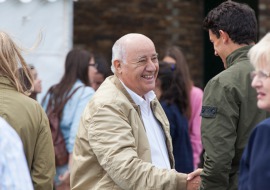Schoolboy, 4, over the moon with Nasa's help on his homework
Four-year-old Lucas Whiteley wrote to Nasa asking for help on a school project and became the star of his class when the space agency replied
It was one small step for a Nasa engineer but one giant leap for a four-year-old schoolboy from Yorkshire who wrote to the space agency asking for help with a science project.
Lucas Whiteley enlisted the help of his father to record a video of himself asking three questions which he posted on the Nasa website and was over the moon when the space agency replied.
He was sent a an email and 10-minute film from the space agency’s engineer Ted Garbeff which included a virtual tour of his Mountain View base in California.
Lucas presented the video to delighted teachers at Sunny Hill Primary in Wrenthorpe, West Yorks, who played it at the school assembly.
Mr Garbeff, an expert in experimental fluid physics who studies the wake of space capsules, answered Lucas’s queries about the number of stars, which countries had landed on the Moon and whether any animals had been there.
4 year old Lucas Whiteley got a detailed reply from NASA (Photo: Ross Parry)
He explained the huge number of stars by comparing them to grains of sand on a beach.
“You might see a lot of stars, but the truth is there are more stars than you can even see,” he wrote.
“There are so many stars that it’s really hard to imagine how many there are.”
Mr Garbeff also told Lucas that the US was the only country to put a man on the moon but that Russia and then China had landed rovers and he described the role of animals in space exploration including Russian dog Laika, the first living thing to be sent into space.
Lucas’s father James Whiteley, 37, of Roberttown, West Yorks, said: “When I was a kid I wrote to
NASA and got a brochure, so when Lucas was doing a project on space I thought
we might be lucky if we sent a video of Lucas asking some questions.
“What we got back was amazing. Obviously Ted has thought about his audience and
gone to a lot of trouble just for them.
“When I sat down to watch it with Lucas he had a big smile on his face.
“Ted is a fantastic bloke to go out of his way to do something for someone he
doesn't know on the other side of the world.”
In his response to Lucas, Mr Garbeff claimed it had been difficult to get his job at NASA and urged Lucas and his classmates to listen to their teachers, adding he hoped to see them all "up in space one day."
He said the video had been "super fun" to make, "especially as Lucas asked such
great questions."
He added: "I'm always happy to talk about NASA."
Lucas’s questions and Mr Garbeff’s answers
Q: How many stars are there?
A: You might see a lot of stars, but the truth is there are more stars than you can even see. There are so many stars that it’s really hard to imagine how many there are. So we haven’t counted every single star in the universe, that would take a really long time. But instead engineers and scientists are really good at estimating really large numbers.
- he told Lucas there were about 1,000,000,000,000,000,000,000,000 stars.
Q: Who came second and third in the race to the moon?
A: The US did land the first people on the moon and in fact no other country has made it back to the moon. But Russia did manage to land a rover on the moon to drive around. So I guess I would probably give Russia second place. Very recently, a country called China has landed a rover on the moon so China would have third place.
Q: Did any animals go to the moon?
A: No. But animals have really helped us understand the way space works and how well humans can live in space. In fact one of the first living things to go into space was a Russian dog named Laika. Laika’s now very much a space hero. She was the first living thing to go into space. Nasa also launched animals into space (including) the first primate, a chimpanzee named Ham. But none of them made it to the moon, they orbited around the Earth.











,+1866.jpg.CROP.original-original.+Rue+de+Constantine+(Fourth+Arrondissement),+1866.jpg)
,+1877-78.jpg.CROP.original-original.+Top+of+the+rue+Champlain,+View+to+the+Right+(Twentieth+Arrondissement),+1877-78.jpg)
,+ca.+1862.jpg.CROP.original-original.+Banks+of+the+Bie%CC%80vre+River+at+the+Bottom+of+the+rue+des+Gobelins+(Fifth+Arrondissement),+ca.jpg)
,+1865.jpg.CROP.original-original.+Impasse+de+la+Bouteille+from+the+rue+Montorgeuil+(Second+Arrondissement),+1865+(2).jpg)


,+1866-68.jpg.CROP.original-original.+Rue+de+la+Bu%CC%82cherie+from+the+cul+de+sac+Saint-Ambroise+(Fifth+Arrondissement),+1866-68.jpg)
,+1863-65.jpg.CROP.original-original.+Passage+Saint-Guillaume+toward+the+rue+Richilieu+(First+Arrondissement),+1863-65.jpg)

,+1866-67.jpg.CROP.original-original.+Cour+Saint-Guillaume+(Ninth+Arrondissement),+1866-67.jpg)

























